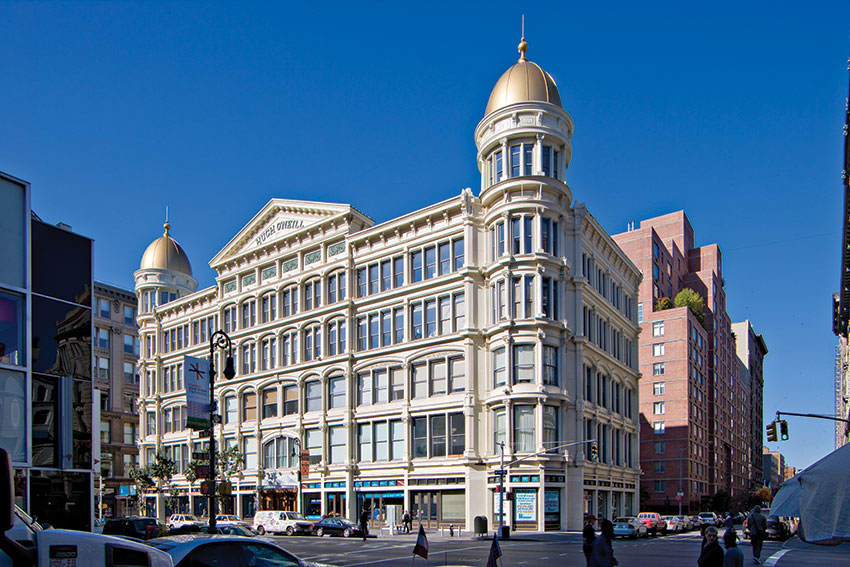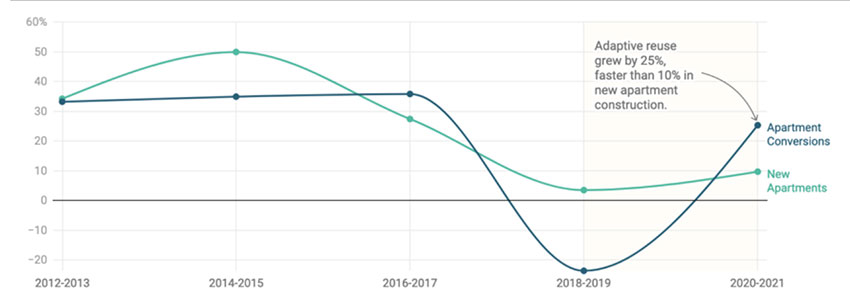Site Selection Criteria for Commercial-to-Residential Conversions
Learning Objectives:
- Explain the relations of floorplate size and shape, ceiling height, building age, and other building features to successful conversion.
- List and describe factors that can affect or limit residential conversion.
- Apply features of existing commercial buildings to new residential uses.
- Explain how creating voids in an existing structure can develop amenities and how transferring the usable area to new stories atop a building can require structural support.
- Discuss how relations between a commercial building and its surrounding community can increase or decrease suitability for residential conversion.
Credits:
This course is approved as a Structured Course
This course can be self-reported to the AANB, as per their CE Guidelines
Approved for structured learning
Approved for Core Learning
This course can be self-reported to the NLAA
Course may qualify for Learning Hours with NWTAA
Course eligible for OAA Learning Hours
This course is approved as a core course
This course can be self-reported for Learning Units to the Architectural Institute of British Columbia
The COVID-19 pandemic and ensuing workplace changes have increased attention to an enduring anomaly in the national built environment: a glut of commercial space coexisting with a housing shortage. The question has naturally arisen: Can some of the former resources be repurposed to address the latter need? Architects with experience in adaptive reuse add a corollary question: Can the transformation of commercial properties to residences yield desirable homes, buildings, neighborhoods, and cities?

Photo courtesy of © Alan Schindler
The Hugh O'Neill Building (Mortimer C. Merritt, 1887), New York City, converted from commercial to residential use by CetraRuddy in 2005.
The first question, commentators suggest, has been answered “yes, theoretically” more often than “yes, and here's the living proof: a boom in conversion projects.” Reflection on the second question explains why such a boom may be slower to start than some have hoped, but may gain momentum in the foreseeable future, given a set of appropriate policy and economic incentives and prudently imaginative choices of prospective sites.
Commercial real estate markets softened dramatically when large numbers of office workers, unprotected by vaccines until December 2020, began working remotely. As many workers and employers have discovered the feasibility of work from home or hybrid schedules, demand for office space as the pandemic wanes has not sprung back to pre-pandemic levels. Coldwell Banker Richard Ellis (CBRE) reported a national commercial vacancy rate of 17 percent in the third quarter of 2022, continuing to rise as new supply outstrips demand, with class A space accounting for all net demand, class B/C demand actually negative, and downtown vacancy rates surpassing suburban for the past two quarters (CBRE, 2022). A Jones Lang LaSalle report on the same period calculated the national vacancy rate at a record 19.1 percent (Jones Lang LaSalle, 2022).
Business Insider recently labeled today's conditions an “office apocalypse,” with pre-pandemic occupancy rates of 95 percent now falling below 50 percent (Skandul, 2022). Collateral effects have lowered multiple variables reflecting business districts' vigor: not just office occupancy and commercial real estate values but employment, foot traffic, business spending, transit ridership, public services, and property-tax revenues for cities nationwide. Apocalyptic rhetoric is not limited to journalistic contexts; the same term appears in a detailed report by scholars at NYU and Columbia Business Schools, posted on the Social Science Research Network, calculating that remote work had caused “a $413-billion value destruction” in the U.S. commercial office sector (Gupta et al., 2022).

Source: RentCafe analysis of Yardi Matrix data (Neculae, 2022).
Figure 1. Percentage increases in adaptive-reuse apartments in 2020-2021 became higher than in new apartments. Source: RentCafe analysis of Yardi Matrix data (Neculae, 2022).
The idea of converting commercial real estate to residential has the intuitive appeal of solving two problems at once: helping to relieve the housing shortage in high-demand urban areas and adding new forms of value to spaces that have been neglected, abandoned, or rendered less marketable. Research suggests that residential adaptive reuse is indeed rising, with about 28,000 new rental units nationwide between January 2020 and December 2021, 11,000 of which (about 40 percent) were in the office-to-residential niche (Kolomatsky, 2022), increasing at a faster rate than new apartments (Neculae, 2022) (see Figure 1). Other building types chosen for conversion during these years included factories (15.5 percent), hotels (12.8 percent), and warehouses (9.0 percent), followed by health care, educational, and religious buildings. (These figures are from the real estate research group RentCafe, which studies Yardi Matrix data on conversions into residential buildings with at least 50 units; smaller-scale conversions, assuming these are above zero, logically imply that RentCafe's counts are conservative, possibly underestimates.)
The National Apartment Association, tracking rising numbers of conversions since 2010, has offered roughly comparable figures, noting that offices have overtaken hotels as the leading target type despite a COVID-19-related rise in hotel conversions (Miller, 2022). Office conversion is most common in “larger, more historic cities,” with 1,000 to 2,000 conversions seen in Philadelphia, Washington, D.C., Cleveland, Chicago, and Los Angeles. Curiously, the NAA's report says little about New York City's conversions, though these have become prominent through media coverage, the Skyscraper Museum's “Residential Rising” exhibition on downtown Manhattan's transformations since the 1990s, and city government's creation of an Office Adaptive Reuse Task Force in July 2022. Such conversions, one should note, still represent a relatively small phenomenon within the real estate context, contrasting with 791,081 newly constructed rental units nationwide during 2020-2021, according to RentCafe (see Figure 1 above).
Converted office buildings, particularly from before World War II, offer dwellers an array of advantages, says James McLane, AIA, director of technology at Page & Turnbull, a San Francisco-based firm focusing on renovation and preservation. Their formal lobby spaces and corridors are character-defining features; they often have ground-level commercial spaces with high ceilings, readily adapted into amenities such as fitness centers, cafés, or mobile work centers; many have balconies, tall story heights and windows, and narrow floorplates. These buildings are sometimes associated with federal tax credit opportunities or reductions in local parking requirements, McLane adds. Another benefit is that the conversion process is generally less physically disruptive to a neighborhood than new construction. “Projects of this nature,” he says, “are opportunities to fix the wrongs that we've done to our downtowns and revitalize them.”
John Cetra, founding principal of New York firm CetraRuddy, has worked on several of the city's most prominent conversion projects and sees this sector as ripe for expansion. “People are not using office space to the same degree that they had been before COVID,” he says, recounting a recent client conversation about an office building undergoing extensive renovation. “We've been working on the plans for over a year, and we have no new tenants lined up. So they're calling me and saying, 'What can we do with this building? Can we look at that quickly and see if it's a viable candidate for either mixed use or total conversion to residential use?' So, I think we're going to see more.”
In practice, some sites and building categories are well-suited to this form of adaptive reuse, while others look promising from afar but turn out to be cases of wishful thinking when analyzed in detail. Certain relevant architectural variables are obvious; some, not so obvious, until investigation of a proposed project leads to practical obstacles or deal-breaking costs. In some instances, nonarchitectural factors such as zoning or finance become deal-killers before architectural considerations even arise. (The financial and policy particulars of commercial-to-residential conversions are largely beyond the scope of this discussion, though they provide the background conditions for the architectural decisions considered here.)
Proponents of conversions cite benefits including easier permitting, low construction costs, lighter environmental footprints, and partial leasability during conversion (Kiger, 2022; Malizia, 2022). However, Peter Bafitis, managing principal of New York firm RKTB and chair of AIA-New York's Housing Committee, comments, “The truth of the matter is, conversions are not inexpensive things; they are expensive and complicated, among the most complicated. I have always said that adapting a building, reusing it, is far more complicated than building something from scratch. You have to work with what's there, and often, you have to understand an older technology and bend it to your will, and then figure out how to get new services and utilities in it.” With those caveats in place, he remains enthusiastic about the practice: “You can make any building work, and you can adapt any building; I fully believe that there's no building where that is not possible. It's just that from a development perspective, you just have to be prepared for the unexpected” (see case studies and Figures 2 and 3).
As a guiding principle for a sustainable built environment, Bafitis cites with approval the motto of Pritzker Prize winners Anne Lacaton and Jean-Philippe Vassal: “Never demolish. Never subtract, remove, or replace. Always add, transform, and utilize, with and for the inhabitants.” Transforming the category of inhabitants themselves from office workers to residents calls for assessments on multiple levels, from the spatial and the material to the civic and the global, along with an awareness that economic considerations do not always harmonize with choices that otherwise look like win/win outcomes for most parties involved.

















